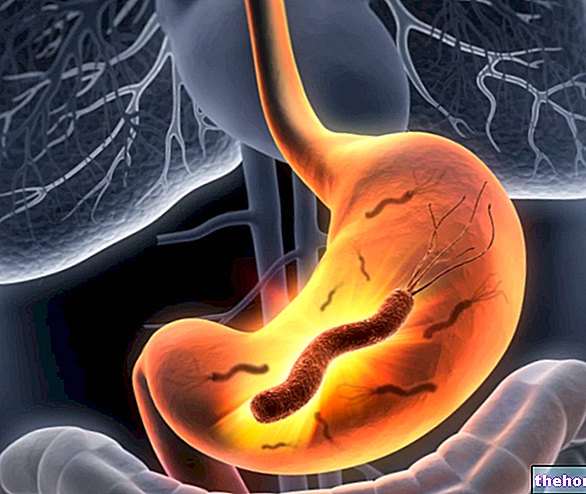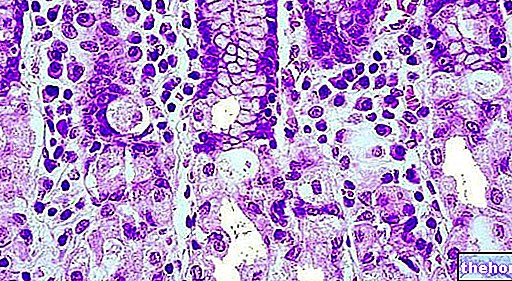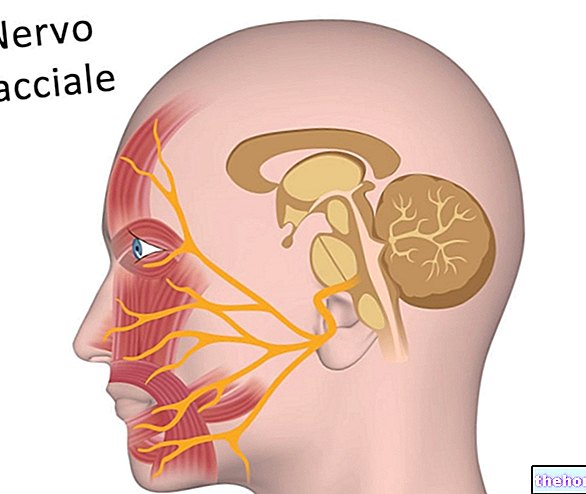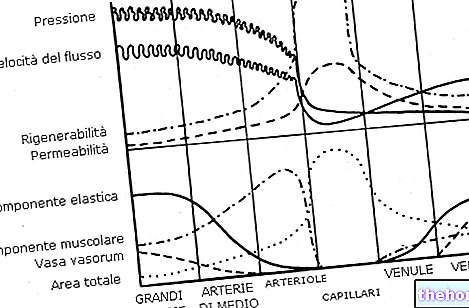Generality
Nausea is a symptom consisting of a feeling of sickness in the upper part of the stomach; this malaise can spread to the chest or back of the throat and is often associated with a feeling of vomiting.
The causes of nausea are numerous.

Nausea should cause concern when it is associated with: head trauma, headache, severe abdominal pain, etc.
Only an adequate diagnosis allows to establish the correct treatment; treatment that depends on the severity of the symptoms and the triggering causes.
What is nausea?
Nausea is a general medical term that describes an upper stomach discomfort, most often accompanied by a particular feeling of vomiting.
Nausea is a symptom and not a condition; it is very common and characterizes a large number of diseases.
The feeling of vomiting, which accompanies most episodes of nausea, may remain so or may result in actual vomiting.
Causes
Nausea can be the result of problems involving:
- The abdominal or pelvic organs.
The most common abdominal or pelvic conditions, capable of inducing nausea, are: hepatitis (inflammation of the liver), pancreatitis (inflammation of the pancreas), intestinal obstruction, gastric volvulus, gastroesophageal reflux disease, a state of constipation, gastritis, appendicitis, colitis, gastroenteritis, pyelonephritis (inflammation of the kidneys), kidney failure and gallbladder diseases.
Episodes of nausea caused by menstruation in women also fall into this category. - The brain, the cerebrospinal fluid (or cerebrospinal fluid or CSF) and the nervous system in general
Problems affecting the nervous system that can cause nausea are: migraines, head trauma, brain tumors, stroke, brain haemorrhages, meningitis (inflammation of the meninges) and damage to the optic nerve responsible for glaucoma .
Episodes of nausea triggered by certain smells or visions also fall into this category: even in such situations, in fact, nausea has a "nervous origin." - The balance centers of the inner ear.
Generally, dizziness results from a dysfunction of the balance centers of the inner ear.The presence of vertigo produces, in the affected person, the sensation that the surrounding environment is moving or rotating.
Nausea is a very common accompanying symptom of vertigo.
The conditions that most commonly cause vertigo are: benign paroxysmal positional vertigo (BPPV), labyrinthitis, vestibular neuronitis, Ménière's syndrome, and motion sickness.
Nausea is also a common side effect of those biochemical changes induced in the human body by:
- Female reproductive hormones, during pregnancy or when using the birth control pill. According to some clinical surveys, about 50% of pregnant women suffer from morning sickness during the first months of pregnancy.
- Some pharmacological substances. The most well-known drugs that, among the side effects, present nausea are chemotherapy drugs and antidepressants.
- A state of hypoglycemia. Hypoglycemia is the medical term for a lower than normal blood glucose level.
- Alcohol abuse. Nausea is a typical sign of alcohol intoxication.
- General anesthesia. Upon awakening from general anesthesia, an individual may experience various sensations, such as confusion, lightheadedness, sluggishness and indeed nausea.
- Some food allergies.
Associated symptoms
For further information: Nausea - Causes and Symptoms
There are many descriptions of nausea.
For some, it is a malaise that begins in the stomach and rises to the back of the throat; for someone else, it is an unpleasant sensation felt between the stomach and chest.
The symptoms and signs that can accompany nausea are numerous. We have already talked about the sense of vomiting and vomiting: these two are the main accompanying disturbances.
Two other clinical manifestations that are often associated with nausea are disgust for food and profuse sweating: the first is typical of episodes of nausea caused by abdominal or pelvic conditions; the second, on the other hand, is typical of the episodes of nausea following problems of the balance centers (eg motion sickness).
LENGTH OF THE SENSE OF NAUSEA
The duration of the feeling of nausea varies according to the triggering condition.
For example, episodes of motion sickness or the most common viral diseases affecting the gastrointestinal tract (gastroenteritis, etc.) produce short-term nausea.
Conversely, a serious problem, such as brain tumors, migraines or head trauma, can lead to recurrent nausea.

HE RETCHED
In the body of an individual who is about to vomit, it happens that:
- The cardia, the muscular ring located between the esophagus and stomach, relaxes. The cardia is also known as the upper esophageal sphincter;
- The abdominal muscles and diaphragm contract;
- The larynx closes;
- The lower portion of the stomach contracts.
With vomiting, the victim expels the gastric contents, first through the esophagus and then through the mouth.
WHEN TO SEE THE DOCTOR?
The presence of nausea assumes a "relevant clinical importance, when it is:
- Following a head injury;
- Associated with severe headache;
- Associated with severe abdominal pain;
- Accompanied by vomiting with blood;
- Combined with extreme weakness;
- Combined with high fever;
- Associated with blurred vision or eye pain;
- Accompanied by confusion or stiffness in the neck.
Diagnosis
Nausea is a very nonspecific symptom which, as readers will no doubt have noticed, can characterize both serious and less serious conditions.
Understanding the triggering causes is the fundamental step in interpreting its severity and in establishing the most appropriate therapy.
When dealing with an individual who complains of nausea, doctors usually begin their diagnostic investigations with a physical examination and medical history. Already from an accurate physical examination and a "careful medical history, I am able to understand if the problem deserves further investigation (because it is clinically relevant) or if it is a transient (therefore negligible) discomfort.
Possible in-depth examinations include: blood tests, a pregnancy test (in the case of female patients) and a nuclear magnetic resonance or CT scan of the head.
OBJECTIVE EXAMINATION AND HISTORY
The physical examination is the set of diagnostic maneuvers, carried out by the doctor, to verify the presence or absence, in the patient, of the signs indicative of an abnormal condition. Often, it also includes measuring vital signs, that is: body temperature, pressure, heart rate, etc.
The anamnesis is the collection and critical study of the symptoms and facts of medical interest, reported by the patient or his family.
Treatment
For further information: Drugs for the Treatment of Nausea
Treatment of nausea depends on how severe the feeling is and the type of triggering causes.
Normally, mild nausea episodes of little clinical interest do not require special therapies, at most simple remedies or over-the-counter medicines are used to prevent or limit the problem.
On the contrary, intense nausea episodes of relevant medical interest may require specific anti-nausea drugs and, sometimes, even surgical interventions.
SOME REMEDIES AND MEDICINES FOR LESS SERIOUS CASES
To remedy nausea induced by mild abdominal or pelvic organ problems, doctors recommend:
- Drink beverages that "settle" and regulate the stomach, such as chamomile tea.
- Avoid caffeinated drinks, coffee or tea.
- Feeding on small, but frequent meals. In this way, the digestive process is less "demanding" for the stomach.
- Eat easily digestible foods (so avoid high-fat foods).
- Avoid spicy foods and fried foods.
As for over-the-counter medicines suitable for less severe nausea, they deserve special mention:
- Antacids in chewable tablets or in liquid version, bismuth subsalicylate and solutions based on glucose, fructose and phosphoric acid. They are mainly used to buffer "excessive stomach acid."
- Dimenhydrinate and meclizine hydrochloride. They are used for the treatment and prevention of motion sickness. In addition, they block the brain receptors involved in the motion sickness vomiting mechanism.
As for herbal remedies for nausea, readers can consult the article here.
Read also: Remedies for Nausea »
ANTI-NAUSEA DRUGS
Anti-nausea drugs are indicated in the presence of an intense and persistent feeling of nausea.
These medicines have several side effects, the main one being sleepiness.
As a rule, doctors prohibit its use by women who are pregnant or suspected of being pregnant.
- To learn more about "anti-nausea drugs", readers can consult the article here.
- For medicinal alternatives that can be used in pregnancy, readers can consult the article here.
SURGERY: WHEN CAN IT BE USED?
Surgical practice is essential in the presence of serious conditions such as malignant brain tumors, acoustic neuroma (which is a benign brain tumor), intestinal obstructions, episodes of gastric volvulus, etc.
In such circumstances, nausea is only one of the many symptoms present.
Prognosis
The prognosis for nausea depends on the causes of the malaise.
If the causes are not clinically relevant, nausea has a positive prognosis and recovery usually occurs within 24-48 hours.
Prevention
Not all causes of nausea are preventable.
Below, the reader can consult a series of preventive advice, valid for cases of nausea due to mild abdominal or pelvic problems and cases of nausea from motion sickness:
- Consume many small snacks instead of a few large meals. In this way, digestion is simpler;
- Avoid eating badly stored and bad-looking foods;
- Avoid alcoholic beverages;
- Write down which foods triggered particularly intense nausea; therefore, avoid them in the future;
- If you suffer from motion sickness, in the car it is best to avoid reading and sitting in the central positions (the side seats are less annoying).
Before taking any anti-nausea medication for motion sickness, it is recommended that you consult your doctor.
To learn more, consult the special: Car sickness and movement-related disorders: what to do to prevent them




























